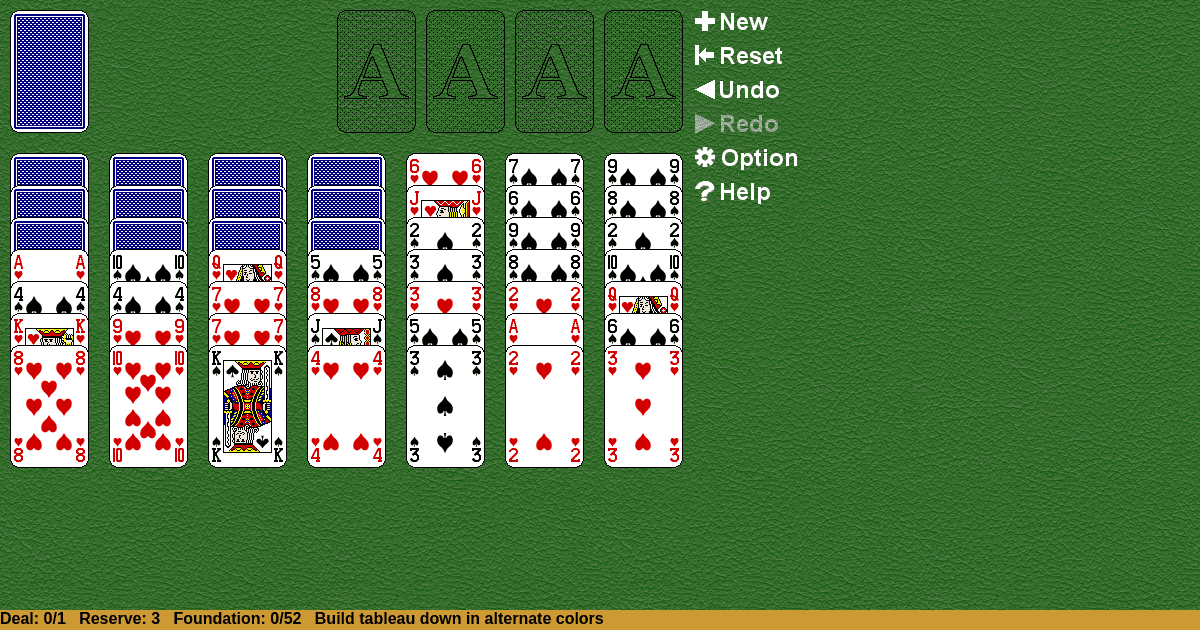Scorpion Tail
Home |
How to play |
FAQ |
About
How to play Scorpion Tail?
Game Objective:
The primary goal in Scorpion Tail Solitaire is to arrange all 52 cards into four complete sequences in the tableau, each running from King down to Ace in the same suit. The game is won when all four such sequences are formed within the tableau.
Setup & Layout:
- Deck: Use a standard 52-card deck.
- Tableau: Deal 49 cards into seven columns, each containing seven cards.
- In the first four columns, the bottom three cards are dealt face down (these are often referred to as the "Scorpion's tail"), and the remaining four cards in each of these columns are dealt face up.
- In the last three columns, all seven cards are dealt face up.
- Stock/Reserve: The remaining three cards are set aside as a reserve or stock pile, to be dealt later in the game.
- Play Areas Defined:
- Tableau: The main area with seven columns where all play occurs.
- Stock/Reserve: Three leftover cards, to be introduced later.
- Foundations: There are no separate foundation piles; completed sequences remain in the tableau.
Scorpion Tail Solitaire Rules:
Building Sequences:
- Cards in the tableau are built downward in the same suit (e.g., 8♠ on 9♠).
- Any face-up card in a column can be moved, along with all cards above it, as a unit.
- The moved group must be placed onto a card of the same suit and one rank higher.
- Groups of cards do not need to be in sequence to be moved; only the bottom card of the group must follow the building rule.
Card Movement:
- When a face-down card becomes the top card of a column (no cards above it), it is immediately turned face up.
- Empty columns may be filled only with a King or a group headed by a King.
Restrictions:
- Nothing can be placed on an Ace.
- Cards cannot be moved to a foundation until a complete King-to-Ace sequence is formed in the tableau.
Gameplay:
Player Actions:
- Move any face-up card (with all cards above it) to another column, provided the move follows the building rules (down in suit, one rank lower).
- Flip any face-down card that becomes exposed at the top of a column.
- Fill empty columns only with Kings or groups headed by a King.
Introducing Stock/Reserve Cards:
- When no further moves are possible (or at the player's discretion), deal the three reserve cards: place one card face up onto each of the first three tableau columns.
No More Moves:
- If, after dealing the reserve cards, no further legal moves are possible and the objective has not been met, the game ends in a loss.
Winning & Losing Conditions:
Winning:
- The game is won when all four complete sequences (King down to Ace in the same suit) are formed in the tableau.
- These sequences must remain undisturbed unless breaking them is necessary to uncover face-down cards.
Losing/Unwinnable State:
- The game is lost if, after all possible moves (including dealing the reserve cards), it is impossible to form all four complete suit sequences.
Special Rules & Edge Cases:
Filling Empty Columns:
- Only a King or a group of cards headed by a King may be placed in an empty column.
- No other cards or groups may fill empty spaces.
Moving Groups:
- Any face-up card and all cards above it can be moved as a unit, regardless of sequence, as long as the bottom card of the group can be legally placed on the destination card (one rank higher, same suit).
Dealing Reserve Cards:
- The reserve (stock) of three cards can only be dealt once per game.
- Each reserve card is placed face up onto the leftmost three tableau columns, in order.
No Foundations:
- Unlike some solitaire games, there are no separate foundation piles; completed sequences remain in the tableau.
Sequence Removal:
- Some implementations allow (or require) removing completed King-to-Ace suit sequences from the tableau, but in traditional rules, they remain in place unless breaking them is needed to access face-down cards.
Game Difficulty:
- Scorpion Tail Solitaire is recognized as a particularly challenging solitaire variant; wins are rare and require careful planning.
This guide is based on the official rules and authoritative sources for Scorpion Tail Solitaire, ensuring strict adherence to the unique mechanics of this variant.

Solitaire Collection
About Scorpion Tail
Rate (Scorpion Tail)
4.7 / 5
1,916 votes



























































